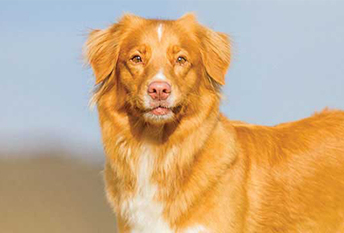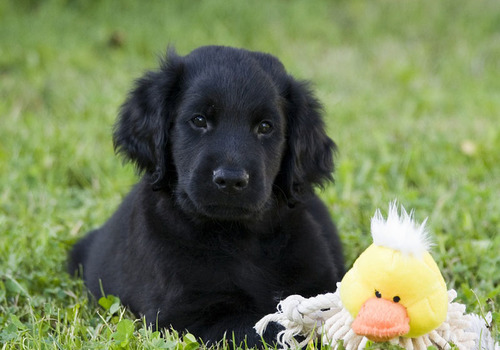This breed has a straight, moderately long coat that stands up to cold weather, cold water, and rough brush. The beautiful coat may look high-maintenance, but it’s easy to care for with weekly brushing to remove dead hair and distribute skin oils.
A Flat-Coat who isn’t a show dog needs only a lick and a promise to stay reasonably clean and attractive. Trim his ears and feet occasionally for neatness if you like. If he spends as much time in the water as a typical Flat-Coat, you probably won’t need to bathe him frequently, but rinse him thoroughly if he’s been in a chlorinated pool, ocean water, or a lake with algae in it.
The rest is basic care. Trim the nails as needed, usually every couple of weeks. Keep the floppy ears clean and dry to ward off bacterial or yeast infections. Brush the teeth frequently for overall good health and fresh breath.
The Flat-Coated Retriever will need 60 to 90 minutes of exercise every day. This breed needs a backyard to run around in, although he will behave himself indoors. But if your dog isn’t getting enough exercise, he’ll take it out on your household possessions.
If you’re part of an active family, the Flat-Coated Retriever is the dog for you. This dog will run and play until you tell him to come inside. Take your Flattie out on all your outdoor activities. This includes hikes, swims, jogs and bike rides.
This is one active dog, so you’ll need to feed your Flat-Coated Retriever accordingly. Depending on what dry-food kibble you are feeding your dog, the amount will range from 3.5 to 4.5 cups a day, divided into two meals. And you should always feed your Flattie a high-quality dry food.
The Flat-Coated Retriever main health concerns are cancer, bloat, hip and elbow dysplasia, entropion, distichiasis, glaucoma and progressive retinal atrophy. As well, this breed can also suffer from hemangiosarcoma, fibrosarcoma, osteosarcoma and malignant histiocytosis.
The Flat-Coated Retriever is slow to mature and this means he can be a bit of a challenge to train. This breed can be willful and will test your boundaries. You’ll need to have plenty of patience and lots of rewards to get your point across with this breed.
Employ positive training techniques with the Flattie for the best results. Harsh discipline will only result in willful behavior, and since this is such a sensitive breed, you won’t make any headway with your training.
House training efforts may prove to be more fruitful. Introduce a crate as soon as possible – this will ensure that your Flat-Coated Retriever will stay out of trouble when you aren’t around to watch him.
Another habit you may need to break your Flattie from is coprophagy (eating poop). Pick up after your dog as soon as he finishes his bathroom break – that way, there will be no delectable morsels for him to eat.












